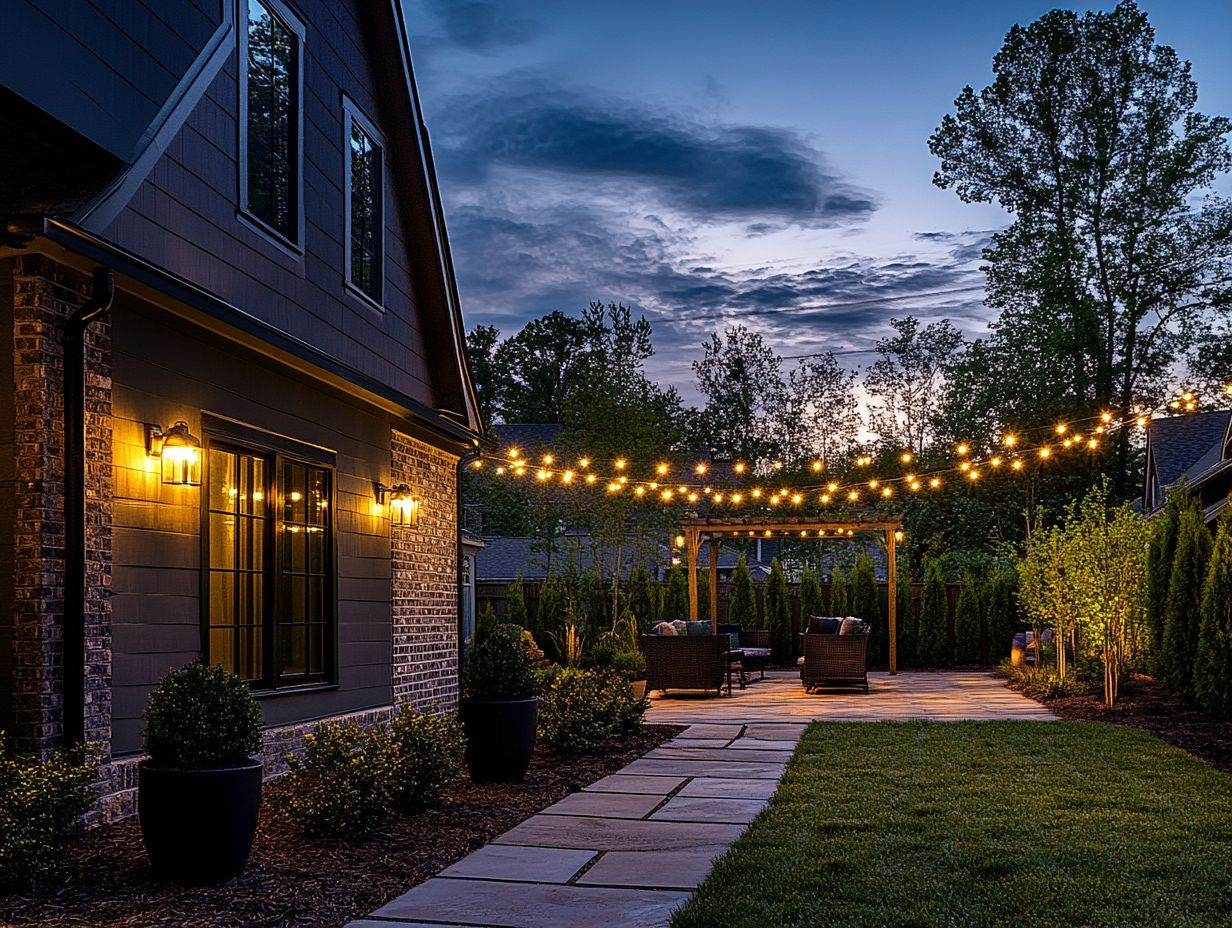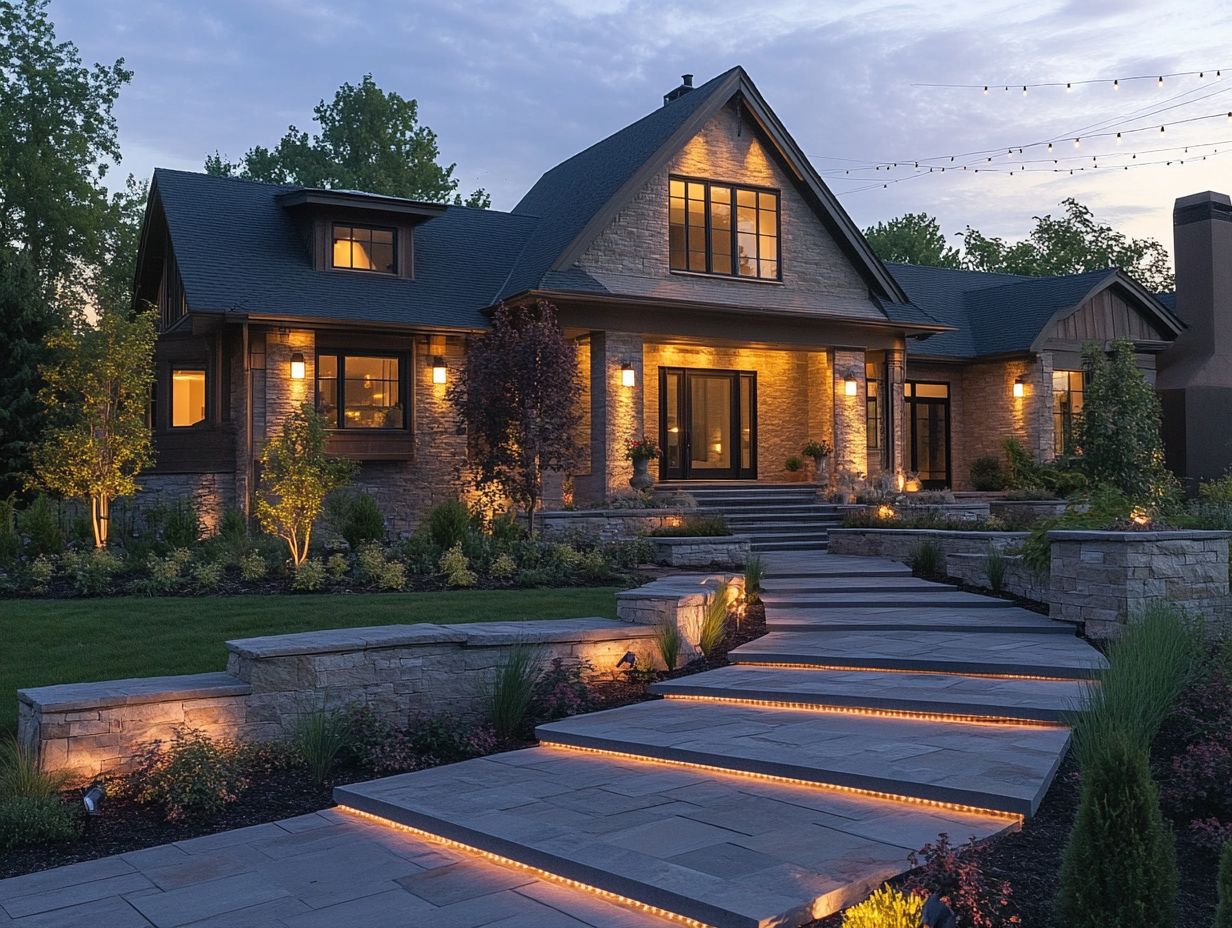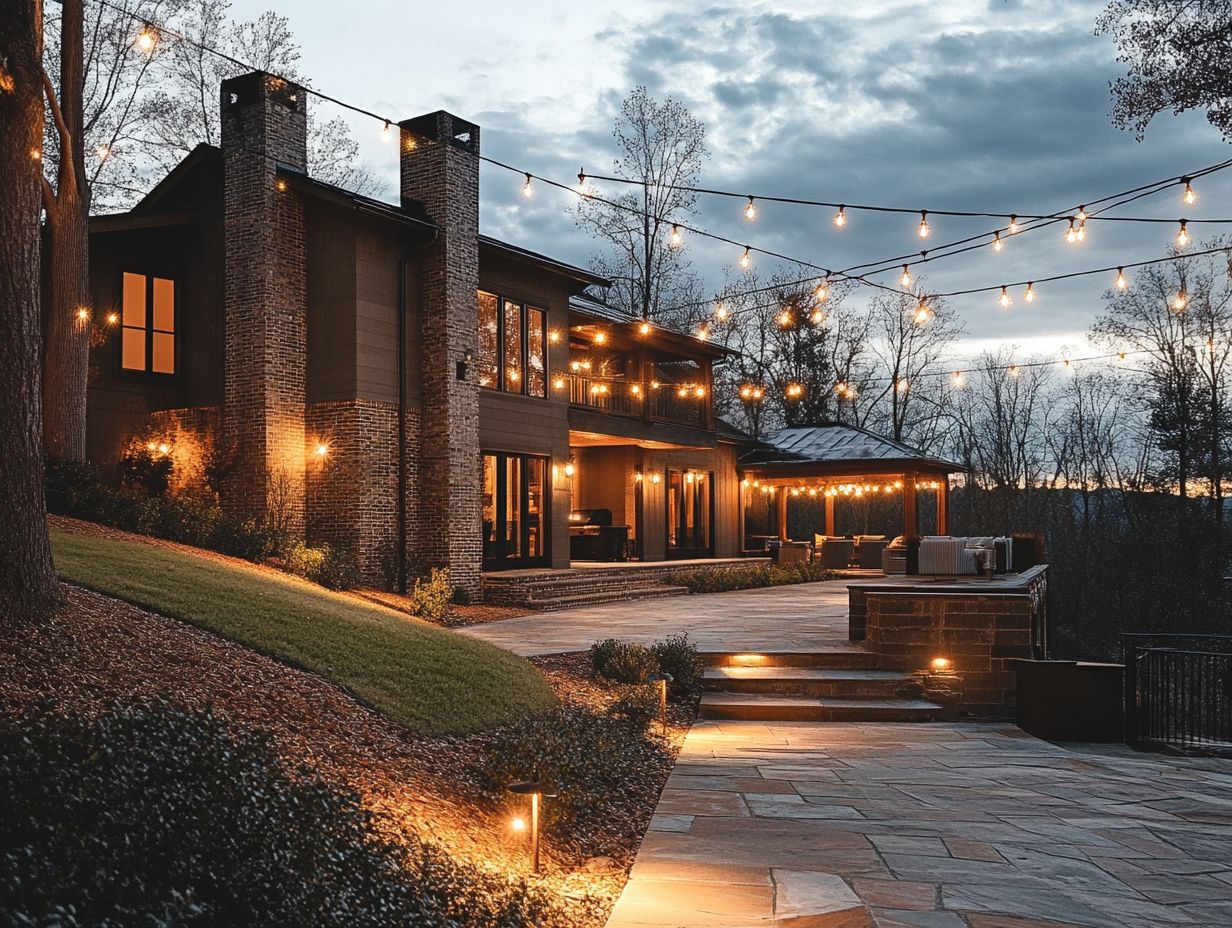When considering the exterior of a residence, lighting plays a vital role in both aesthetics and safety. The appropriate lighting can enhance a property’s curb appeal while also ensuring essential visibility during nighttime hours.
Choosing the ideal fixtures can be overwhelming due to the wide array of styles, sizes, and types available in the market. This guide aims to address the importance of exterior lighting, outline key factors to consider, and provide practical advice for creating a well-lit and inviting outdoor space that complements the home.
The Importance of Exterior Lighting

Exterior lighting is essential for enhancing both the aesthetic appeal and functionality of outdoor spaces, providing homeowners with a valuable opportunity to elevate their property’s curb appeal while ensuring safety and security.
Effective outdoor lighting serves not only to illuminate pathways and architectural features but also to create an inviting atmosphere for gatherings and outdoor entertaining, thereby establishing the appropriate mood for various occasions.
Furthermore, a well-considered lighting design can accentuate landscape features and contribute to the overall value of the property. Recognizing the significance of exterior lighting enables homeowners to make informed decisions when selecting the most suitable lighting solutions for their residences.
Enhancing Curb Appeal and Safety
Enhancing curb appeal and safety through exterior lighting is a comprehensive approach that involves the strategic placement of various lighting fixtures to illuminate pathways, entrances, and surrounding landscaping. Proper illumination not only improves the aesthetic aspects of a home but also significantly enhances safety by preventing accidents and deterring potential intruders. The utilization of a combination of task lighting, accent lighting, and decorative fixtures can create a visually appealing outdoor space that welcomes guests while ensuring functional safety.
To achieve this objective, the incorporation of path lighting is essential, as they delineate walking areas and guide visitors comfortably towards doorways. Wall sconces can also add an elegant touch to entrances while providing enhanced visibility for both homeowners and guests. It is important to recognize that adequate illumination not only beautifies the landscape but also plays a crucial role in security. Well-lit exteriors discourage unwanted visitors and facilitate easier navigation after dark, particularly when utilizing motion sensor lights.
By carefully selecting and positioning these lighting solutions, one can achieve an optimal balance between style and safety in outdoor spaces.
Factors to Consider when Choosing Exterior Lighting
Selecting the appropriate exterior lighting for a home necessitates thorough consideration of several key factors, including the overall design style of the residence, the intended functionality of the lighting, and the requirements for installation and maintenance.
Each of these elements is crucial in ensuring that the outdoor lighting fulfills both aesthetic and functional objectives while also remaining energy-efficient and durable over time.
By assessing lighting placement, choosing suitable lighting fixtures, and exploring energy-saving options, one can effectively achieve optimal lighting for outdoor spaces.
Size and Style

Selecting the appropriate size and style of lighting fixtures is crucial for establishing a cohesive aesthetic that complements the design of your home and enhances outdoor decor. Properly sized fixtures ensure that the lighting achieves a balanced effect, neither overpowering nor underwhelming, thus contributing to visual comfort in outdoor spaces.
By choosing from a diverse range of fixture styles—such as modern, vintage, or rustic—you can effectively align your lighting choices with the architectural features of your home.
Moreover, it is important to consider how these elements interact with the surrounding landscape, as this significantly enhances curb appeal. For example, a strategically placed pendant or wall-mounted fixture can accentuate decorative elements such as pathway stones or flowerbed lighting, thereby making your outdoor space more inviting and effectively using decorative lighting.
The key lies in achieving a balance between form and function, ensuring that the lighting not only complements but also enhances the visual appeal of your property, ultimately creating an inviting atmosphere that attracts positive attention.
Lighting Placement
Effective lighting placement is essential for maximizing both illumination and functionality in outdoor spaces. This approach ensures that each area is sufficiently lit while simultaneously enhancing aesthetic appeal. Strategic placement of lighting fixtures can significantly improve safety by illuminating pathways, steps, and entrances, thereby reducing the risk of accidents during nighttime.
Thoughtful lighting design also creates visual interest and guides the flow of outdoor entertaining areas, enhancing the overall ambiance of the space.
For example, incorporating path lights along walkways not only provides necessary visibility but also contributes to a charming ambiance, inviting guests to navigate smoothly. Flood lights, when strategically positioned to cover expansive areas, can enhance security by illuminating dark corners and entry points, thus deterring potential intruders.
Utilizing adjustable fixtures enables homeowners to customize brightness and light angles, ensuring functionality without overwhelming the space. By prioritizing these practical considerations, outdoor lighting can effectively blend safety with style, transforming a standard yard into a beautifully illuminated haven.
Energy Efficiency
Energy efficiency is a critical factor to consider when selecting exterior lighting, as it influences both budgetary constraints and the environmental impact of lighting solutions. Implementing energy-saving alternatives, such as LED lights and solar lights, can substantially lower energy consumption while delivering high-quality illumination for outdoor areas. These options not only lead to savings on utility bills but also promote a more sustainable lifestyle by reducing environmental footprints. Additionally, understanding wattage and lumens can help in selecting the right fixtures for optimal brightness.
By adopting these modern lighting solutions, both homeowners and businesses can undertake a long-term investment that yields significant returns over time. LED lights offer an exceptional lifespan, often exceeding 25,000 hours, which translates to fewer replacements and decreased waste. Conversely, solar lights utilize sunlight for operation, thereby eliminating electricity costs during daylight hours.
By thoroughly assessing these energy-efficient options, individuals can make informed lighting choices that align with their financial strategies while ensuring an aesthetically pleasing and functional outdoor environment.
Types of Exterior Lighting

Numerous types of exterior lighting options exist, each specifically designed to serve distinct purposes and enhance the overall aesthetic appeal of outdoor spaces. From security lighting to ambient lighting, the choices are diverse and impactful.
Wall lights offer illumination for areas such as entrances and patios, while pathway lights effectively guide visitors along walkways, ensuring safe navigation during the evening hours. Additionally, options like porch lights can enhance the welcoming nature of these spaces.
Flood lights and spotlights are particularly suited for accentuating architectural features and landscape elements, thereby creating visual interest and bolstering security through their brightness.
Wall Lights
Wall lights serve as a crucial aspect of outdoor lighting, offering essential illumination and enhancing the aesthetic appeal of residential properties. These fixtures can be strategically positioned near entrances, patios, or along walls to improve safety while contributing a stylish element to the exterior of the home.
Available in a variety of styles and brightness levels, wall lights can effectively complement the overall design and architectural features of a residence.
From contemporary wall sconces characterized by sleek lines to vintage-inspired lanterns that convey classic charm, each style has the potential to significantly transform the ambiance of a space. Optimal placements include flanking doorways to create a welcoming atmosphere or providing brighter illumination over seating areas to foster warmth during evening gatherings.
The judicious selection of wall lighting not only illuminates pathways and gardens but also accentuates architectural details and landscaping, thereby enhancing the visual appeal of outdoor areas while promoting safety and functionality.
Pathway Lights
Pathway lights are essential for enhancing outdoor safety by illuminating walkways and effectively guiding visitors during evening hours. These fixtures provide crucial illumination while also serving as decorative elements that enhance the overall ambiance of outdoor spaces. Available in a wide range of designs, pathway lights can complement the architectural style of a home while creating a warm and inviting atmosphere.
From classic lantern styles to contemporary designs, the variety of options ensures that there is something suitable for every aesthetic preference. Some models even incorporate solar technology, providing an eco-friendly solution that utilizes sunlight for illumination without the necessity of wiring.
Along with their aesthetic benefits, these lights significantly enhance visibility, thereby reducing the risk of slips and falls, particularly in poorly lit areas. They can be strategically positioned along driveways, gardens, and patios, ensuring that every pathway is not only safe but also aesthetically pleasing. The integration of pathway lights in outdoor settings contributes significantly to both functionality and visual appeal.
Spotlights

Spotlights represent a versatile option in exterior lighting, specifically designed to emphasize particular features within a landscape or the architectural elements of a residence. They provide focused illumination, enabling homeowners to create dramatic lighting effects that enhance visual interest in outdoor spaces, particularly during evening gatherings or outdoor entertainment.
The brightness and color temperature of spotlights can be adjusted to achieve the desired atmosphere, whether for safety or aesthetic purposes.
These lighting fixtures are particularly effective for accentuating trees, sculptures, or pathways, thereby enriching the overall ambiance of a garden. By varying the brightness settings, one can effortlessly transition the mood from a soft, romantic glow suitable for intimate evenings to a brighter, more vibrant light that serves both decorative and security functions.
The strategic placement of spotlights can create layers of light that transform an ordinary landscape into a captivating nighttime retreat, allowing the beauty of nature to be appreciated even after sunset.
Floodlights
Floodlights are powerful outdoor lighting fixtures specifically designed to provide extensive illumination across larger areas, making them an excellent choice for enhancing security and safety in outdoor environments. These fixtures are commonly utilized for lighting driveways, backyards, and commercial properties, ensuring visibility even in low-light conditions.
With their robust construction and weather-resistant features, floodlights offer durability while significantly contributing to nighttime safety and security.
The versatility of these lighting solutions allows for strategic placement aimed at detering potential intruders while fostering a more inviting atmosphere. Many floodlights are equipped with adjustable angles, enabling users to direct light precisely where it is needed most. Furthermore, numerous modern floodlights come with motion sensors, which not only conserve energy by activating solely upon detecting movement but also serve as an additional layer of security.
Incorporating floodlights into an overall lighting design can create balanced illumination that enhances the aesthetic appeal of outdoor spaces while prioritizing safety and visibility.
Tips for Choosing the Right Lighting for Your Home
Selecting the appropriate lighting for one’s home necessitates a careful approach that takes into account several factors, including the architectural style of the residence, the surrounding environment, and the intended use of outdoor spaces.
A meticulously designed lighting plan can facilitate the harmonious integration of various fixtures, achieving both functionality and aesthetic appeal. By aligning lighting selections with the overall design style, one can create an inviting atmosphere that enhances outdoor entertaining and complements the existing outdoor decor.
Matching Lighting to Your Home’s Style
Matching lighting to the style of your home is crucial for achieving design coherence and enhancing the overall aesthetic appeal of the property. Various fixture styles, such as modern, rustic, or vintage lighting, can significantly influence the atmosphere of outdoor spaces, making it essential to select fixtures that align with the architectural features of the home. By harmonizing outdoor lighting with the home’s design style, one can create a seamless transition between indoor and outdoor areas.
For example, a sleek, minimalist design can greatly benefit from contemporary lighting fixtures characterized by clean lines and metallic finishes, thereby emphasizing simplicity and elegance. In contrast, a cozy cottage-style home may be enhanced by the addition of wrought iron lanterns and warm-toned bulbs that evoke charm and intimacy. Similarly, mid-century modern homes often achieve the best results with geometric pendant lights or tripod lamps, effectively blending functionality with artistic flair.
Recognizing the relationship between lighting styles and architectural themes facilitates the creation of a richer, more inviting environment that resonates with individual taste.
Creating a Lighting Plan
Creating a lighting plan is an essential step in ensuring that outdoor spaces are illuminated effectively while maximizing functionality and safety. By assessing various outdoor zones, such as pathways, patios, and entrances, one can strategically position different lighting fixtures to enhance visibility and ambiance. A well-designed lighting layout can effectively highlight landscape features, improve outdoor safety, and contribute to the overall aesthetic appeal.
To achieve this, one should begin by mapping out each area of the outdoor space, taking note of the purpose and frequency of use for each zone. Subsequently, it is important to determine the type of fixtures best suited for each area, considering factors such as brightness, style, and energy efficiency.
It is crucial to ensure that the lighting fixtures are installed at appropriate heights and distances to minimize glare and shadows. Additionally, incorporating safety features such as timers and motion sensors can enhance security, making the outdoor environment not only visually appealing but also safer for navigation at night.
Considering the Surrounding Environment
Considering the surrounding environment is crucial when selecting exterior lighting, as it significantly impacts both the effectiveness and aesthetic appeal of the design. Factors such as landscaping, existing architectural features, and local wildlife must be carefully evaluated to ensure that the lighting solutions harmoniously complement the outdoor spaces.
Incorporating eco-friendly lighting options enhances sustainability while minimizing environmental impact.
Assessing the ambient light levels in the area, along with the intended use of the space, can inform the selection of appropriate fixtures and brightness levels. A strategic approach to lighting not only promotes energy efficiency but also respects the local ecosystem, thereby reducing light pollution and protecting nocturnal wildlife.
Choosing materials that are sustainably sourced contributes to the longevity of the installation and reduces its overall carbon footprint. This comprehensive evaluation guarantees that the selected lighting not only fulfills its primary function but also integrates seamlessly into the natural surroundings, creating a beautifully illuminated environment that reflects principles of sustainability.